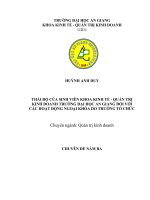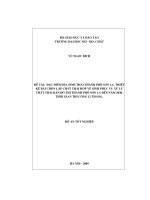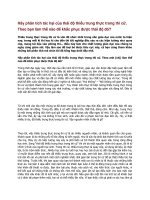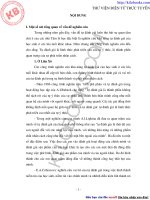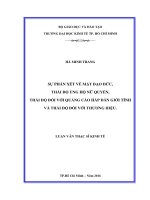Thái độ của sinh viên về việc áp dụng phương pháp học hướng vào ngữ pháp trong lớp tiếng Anh giao tiếp
Bạn đang xem bản rút gọn của tài liệu. Xem và tải ngay bản đầy đủ của tài liệu tại đây (288.39 KB, 11 trang )
STUDENTS’ ATTITUDES TOWARDS THE APPLICATION
OF FORM-FOCUSED INSTRUCTION IN THE
OMMUNICATIVE CLASSROOM
Lu Đinh Bao1
Abstract: Form-focused instruction (FFI) is an effective teaching technique for
enhancing learners’ accurate oral performance. This action research aims at investigating
the impacts of FFI in the communicative teaching context through students’ attitudes.
In order to teach learners how to use past tenses in communication, the picture-based
storytelling activity was applied in a 26-EFL-student communicative class of a university
in Vietnam. During the treatment, either recast or meta-linguistic instructions, two types
of FFI, was utilised to highlight the accuracy of learners’ oral performance. After 1
month, students were invited to answer a questionnaire measuring their attitude towards
the application of FFI in class. The findings revealed students’ positive attitude towards
FFI. However, there came 06 students providing opposite opinions. The focused-group
interview was employed to clarify these students’ opinions. The yielded data proposed
some recommendations for the second circle of this action research.
Keywords: form-focused instruction, Communicative language teaching, students’
attitudes, English as a forgein language, corrective feedback
1. Introduction
In my communicative class of freshmen of English language major in a university,
although most students can express themselves by using English as a means of
communication, they tend to make certain fundamentally grammatical mistakes when
speaking. As reading upon the issues related to the notion of accuracy in communicative,
the idea of integrating grammar in communicative classes, or form-focused instruction
(FFI), appears to meet my purposes. Spada (1997) put forward the effectiveness of FFI in
arousing learners’ attention to form in the communicative classroom, potentially resulting
in the status of accuracy in speaking. Also, much recent research has advocated for this
positive impact (Mochizuki & Ortega, 2008; Rezaei & Derakhshan, 2011; Profozic,
2013); therefore, FFI could be considered as the promising solution to the on-going
troublesome teaching scenario. Thus, I decided to carry out an action research (AR) on
the effect of the application of FFI in my current communicative class to find a solution
for my teaching context.
From the intended purposes, the research was restricted in the scope of employing
the attitudes of my current learners to measure the FFI’s impacts. Additionally, the
boundaries of the attitudes’ exploration include three main components, namely emotion,
behaviour, and cognition (Jain, 2014). My research question is:
1. MA, Van Lang University
3
STUDENTS’ ATTITUDES TOWARDS THE APPLICATION...
What are the attitudes of freshmen EFL students towards the application of formfocused instruction on their communicative class?
2. Literature review
2.1. FFI techniques
Among FFI techniques, Corrective Feedback (CF) has always been under the
spotlight of either scholars or practitioners in language education (Ellis, 2016). This
attention could be retrieved from the nature of language teaching and learning, in which
teachers tend to provide feedback on students’ errors. Also, people are in favour of CF
due to its confirmative effectiveness in arousing learners’ concentration on form in
communicative contexts.
The most implicit CF type, i.e. recast, is highly supported by Long (2007) as he
pointed out that recast provides opportunities for immediately correcting errors without
the necessity of interrupting the on-going communicative activities. However, if learners
fail to recognise their errors as they are too minor or non salient, recast technique is less
likely to be effective. On the other hand, meta-linguistic feedback, the most explicit CF
type, on account of its intelligible influence on both correcting and highlighting essential
form in communicative interactions. Saito and Loewen (2018) indicated that the solely
utilising of implicit CF seems not to fully effective. Instead, they suggested combining
both implicit and explicit CF so as to maximise the positive influence of FFI in CLT
teaching. Therefore, recast and metalinguistic CF, the two most implicit and explicit
instructional CF types (Ellis, 2016), would be appropriate techniques for the purpose of
scaling up the effectiveness of applying FFI into my teaching context.
Rezaei and Derakhshan (2011) confirmed the effectiveness of recast and
metalinguistic feedback in their research. They applied these two types of FFI on three EFL
classes, namely recast group, metalinguistic group, and control group with 20 students for
each group. students in experiental groups worked in pairs or groups to finish the grammar
activities on the target structures without teachers’ intervention of correction. They then
reflected the experience of carrying out those activities by either oral or written forms and
received the CF either recast or metalinguistic type, depending on their groups. In a 2013
study, Profozic also found that the two implicit types of CF, recast and clarification-requests,
were quite helpful in arousing learners’ interests in the past tenses of French in the form
of story retelling. 52 secondary French learning students participated in the research into
three groups: recast group, clarification-request group, and the control group. The picturebased activities were introduced to 3 groups. Participants had to use the 06 pictures and
some attached information to retell the story. Meanwhile, teachers provided CF for the
treatment groups and no intervention was made in the control group. The task of picturebased narration is a decent selection for the target structures, past tenses. Additionally, the
reviewed research of recast and metalinguistic feedback is a good reference for the current
AR due to its effectiveness in not only arousing participants attraction on form but also
taking further steps to correct the interval errors, either implicitly or explicitly.
4
LU ĐINH BAO
2.2. Students’ attitude
Looking at the components of attitude, Jain (2014) generalised the common ground
among models of attitude with three components, namely affective, behavioural and
cognitive components. Affective component relates to the extent to which individuals
respond emotionally to the phenomena or objects. Behavioural component reflects the
way the attitude affects people’s act and behave, while cognitive component involves
personal belief about the object or phenomenon. To be more specific, Eshghinejad (2016)
contextualised these components into ELT contexts. He described the affective component
as the target language attitude, including the emotional bond between the importance of
the target language and the nature of learners themselves. Correlatively, the behavioural
component involves to what extent the knowledge of the target language helps learners
solve concurrent problems. Cognitive component deals with learners’ beliefs towards the
knowledge of the target language. My research question could be investigated in theses
three components of Eshghineja to comprehensively analyse and synthesise students’
attitude towards the application of FFI in their communicative class.
3. Methodology
3.1. Setting and participants
The research was conducted in a communicative class, namely “speaking 1”
class, of first-year tertiary students majoring in the English language of a university. The
speaking class comprised of 24 sessions, 90 minutes each, for 12 weeks. At the end of
this class, students were expected to tell stories using past, present and future tenses There
come 26 students in the class. All of them are ranked at the elementary level based on the
result of the school proficiency entrance test. Prior to “speaking 1” class, these students
had learned past tenses grammar point, at high school and had been revised at the initial
session of the course ‘speaking 1’.
3.2. The plan for applying FFI
The FFI was applied in 4 weeks, 2 sessions per week, for the purpose of helping
students tell a story using the simple past and past perfect tenses in an appropriate way.
The objective was thorough FFI activities, students could use the mentioned tenses to tell
stories by picture-based narratition.
3.3. Method for data collection and analysis
After 1 month of applying the FFI, I continued with the data collecting stage. For
this AR, the procedure of collection data was devided into two stages, the quantitative
stage following up by qualitative one.
At the initial stage, a questionnaire was employed to generalise students’ attitude to
the effect of the instruction. The 5-point Likert scale questionnaire, adapted from the works
of Eshghinejad (2016), was focused on investigating three aspects, namely emotion, the
behaviour and cognition. The data of the questionnaire was analysed by using the software
5
STUDENTS’ ATTITUDES TOWARDS THE APPLICATION...
SPSS of IBM (version 23) and put forward in the format of statistical tables. After 04
weeks, 06 students were conveniently invited to respond to the piloting questionnaire.
The yielded data was examined the reliability of the questionnaire with Cronbach’s alpha
statistic. Inconsistent items were excluded from the official questionnaire. Eventually, the
official questionnaire was delivered to the rest of the class. The data was then tested the
consistency among items using Cronbach’s alpha to eliminated biased items. In addition,
as the population of the research was quite small, the data of 06 piloting students, after
deleted biased items, was included in the final data of the questionnaire. The result of
the questionnaire helped inform my query of the impact of the application of FFI in my
teaching context. Furthermore, based on the statistic data, I would carefully look at some
salient opinions or negative responses.
For the secondary investigation, the focus group interview was utilised to learn
more about specific attitudes towards the application from the questionnaire. This stage
was an effective supplement for the first one in order to fully respond to the research
questions. The informal communication with semi-structured questions was conducted in
one hour focusing on groups of participants, who shared different attitudes to the whole
popluation. The data for the second stage, collected by note-taking, was synthesised and
presented in the form of themed responses.
4. Findings
4.1. Quantitative results
4.1.1. Piloting stage
Table 1. Item-Total Statistics- emotional aspect
Cronbach's Scale Mean
Scale Variance
Alpha
if Item
if Item Deleted
Deleted
.810
6
Corrected ItemTotal Correlation
Cronbach's Alpha if
Item Deleted
Q1
37.67
15.467
.650
.781
Q2
37.33
17.067
.395
.804
Q3
38.33
13.467
.435
.819
Q4
37.67
15.867
.550
.789
Q5
38.00
15.600
.868
.774
Q6
38.33
13.067
.638
.775
Q7
37.83
14.967
.834
.767
Q8
37.83
14.967
.834
.767
Q9
38.50
17.500
.000
.870
Q10
38.00
15.600
.868
.774
LU ĐINH BAO
Table 2. Item-Total Statistics - behavioural aspect
Cronbach's
Alpha
.776
Q11
Q12
Q13
Q14
Q15
Q16
Q17
Q18
Q19
Scale Mean if
Item Deleted
Scale Variance Corrected Item- Cronbach's Alpha
if Item Deleted Total Correlation if Item Deleted
34.50
34.67
34.33
34.50
34.83
34.83
34.50
34.83
35.00
6.700
7.067
6.667
7.100
6.967
8.967
6.700
6.967
7.200
.635
.534
.700
.480
.319
-.136
.635
.773
.354
.728
.744
.720
.751
.787
.816
.728
.722
.772
Table 3. Item-Total Statistics - cognitive aspect
Cronbach's
Alpha
.824
Q20
Q21
Q22
Q23
Q24
Q25
Q26
Q27
Q28
Scale Mean if Scale Variance if Corrected Item- Cronbach's Alpha
Item Deleted
Item Deleted Total Correlation if Item Deleted
34.17
34.33
34.50
34.33
34.67
34.00
34.67
34.50
34.17
7.767
7.467
7.100
7.867
9.467
6.800
6.667
8.700
6.967
.459
.614
.449
.460
.000
.891
.735
.298
.761
.814
.796
.826
.814
.837
.762
.777
.832
.776
Table 1, 2, 3 presented the overall Cronbach’s alpha coefficient of 06 students.
Although the coefficient figures of the three components are around 0.8 which indicates
a high level of reliability, item Q9 in table 1 should be deleted as its corrected item-total
correlation is under 0.3. Likewise, item Q16 in table 2 and Q24 in table 3 were excluded
so as to increase the internal consistency of behavioural and cognitive items. In brief, from
the piloting data, three items, Q9, Q16, and Q24, were deleted from the questionnaire.
4.1.2. Official collecting stage
Table 4. Item-Total Statistics- emotional aspect
Cronbach's
Scale Mean if Scale Variance if Corrected Item- Cronbach's Alpha
Alpha
Item Deleted
Item Deleted
Total Correlation if Item Deleted
.781
Q1
32.760
13.523
.592
.749
Q2
33.000
14.917
.222
.788
Q3
33.480
12.427
.417
.774
7
STUDENTS’ ATTITUDES TOWARDS THE APPLICATION...
Q4
Q5
Q6
Q7
Q8
Q10
33.120
33.320
33.640
33.360
33.480
33.360
14.110
16.393
11.823
11.990
11.927
11.657
.439
-.102
.534
.870
.680
.655
.765
.821
.751
.708
.726
.728
Table 5. Item-Total Statistics - behavioural aspect
Cronbach's
Scale Mean if Scale Variance if Corrected Item- Cronbach's Alpha
Alpha
Item Deleted
Item Deleted
Total Correlation if Item Deleted
.743
Q11
28.269
9.165
.772
.645
Q12
28.500
10.260
.606
.686
Q13
28.385
9.446
.682
.664
Q14
28.423
11.134
.413
.721
Q15
28.769
11.945
.132
.780
Q17
28.385
12.566
.069
.782
Q18
28.500
10.420
.566
.693
Q19
29.077
10.954
.396
.724
Table 6. Item-Total Statistics - cognitive aspect
Cronbach's
Scale Mean if Scale Variance if Corrected Item- Cronbach's Alpha
Alpha
Item Deleted
Item Deleted
Total Correlation if Item Deleted
.750
Q20
28.154
11.895
.633
.695
Q21
28.692
11.022
.645
.683
Q22
28.577
11.374
.688
.681
Q23
28.423
12.014
.545
.707
Q25
28.154
14.055
.240
.754
Q26
29.000
14.160
-.018
.845
Q27
28.423
11.934
.563
.704
Q28
28.077
11.114
.618
.689
Table 4, 5, 6 presented the data of the official collecting, the set of data was high in
its consistency based on the Cronbach’s alpha result of over 0.7. However,Items with the
corrected item-total correlation under 0.3 should be deleted from the data set; therefore,
Q2 and Q5 in table 4, Q15 and Q17 in table 5, Q25 and Q26 in table 6 were excluded in
further analysing steps.
Table 7 generalised the yielded result of the quantitative stage of research. 26
investigated students revealed their positive attitude towards the application of FFI in
the communicative classroom with the central tendency, performed by the median score,
ranging from 4.00, agree, to 5.00, strongly agree. In other words, the participated students
confirmed the effectiveness of FFI in enhancing the aspect of accuracy in their verbal use
8
LU ĐINH BAO
of past tenses to tell stories. Nevertheless, looking at the standard deviation scores of each
item, although the majority of learners agreed on the positive influence of FFI, it could
be observed that Q3, Q6, Q10, Q21, and Q28 received the most diverse answers. In other
to clarify these variables, the analysis of frequencies procedure was implemented using
SPSS.
Table 7. Descriptive Statistics
Students’
antidote
Std.
Deviation
Q1
26
3.0
5.0
5.000
4.654
.5616
Q3
26
2.0
5.0
4.000
4.000
.9798
Q4
26
3.0
5.0
4.000
4.346
.5616
Emotional
Q6
26
2.0
5.0
4.000
3.846
.9672
aspect
Q7
26
2.0
5.0
4.000
4.115
.6528
Q8
26
2.0
5.0
4.000
4.000
.8000
Q10
26
1.0
5.0
4.000
4.115
.8638
Q11
26
2.0
5.0
4.500
4.346
.7971
Q12
26
2.0
5.0
4.000
4.115
.7114
Behavioural Q13
26
2.0
5.0
4.000
4.231
.8152
Q14
26
2.0
5.0
4.000
4.192
.6939
aspect
Q18
26
2.0
5.0
4.000
4.115
.7114
Q19
26
2.0
5.0
4.000
3.538
.7606
Q20
26
2.0
5.0
4.000
4.346
.6895
Q21
26
1.0
5.0
4.000
3.808
.8494
Cognitive
Q22
26
2.0
5.0
4.000
3.923
.7442
Q23
26
2.0
5.0
4.000
4.077
.7442
aspect
Q27
26
2.0
5.0
4.000
4.077
.7442
Q28
26
1.0
5.0
5.000
4.423
.8566
The two following tables, 8 and 9, indicated the frequency of chosen responses
for the afore-mentioned variables, in terms of emotional and cognitive aspects. In the
emotional component, some students were not really comfortable when receiving CF
from the teacher on their oral performances. Indeed, in items Q3, 11.5% of the participants
revealed their anxiety towards teacher’s instruction on form, whereas 15.4% of students in
Q6 showed their unfavourable emotion to the intervention of teachers’ feedback when they
were participating in the communicative activities. Also, one student strongly objected to
receiving feedbacks in front of peers. Looking at table 9, on both Q21 and Q28, there
was one extreme expression on the ineffectiveness of FFI, or CF technique, on speaking
proficiency, in terms of accuracy.
Items
N
Minimum Maximum Median
Mean
Based on the analysed data of Tables 8 and 9, there came 6 students who provided
different opinions. Interestingly, one of them responded negatively to all 05 items. These
students were invited to the following interview in which they explained the reasons for
their responses and proposed adjustment for the application of FFI from their perspective.
9
STUDENTS’ ATTITUDES TOWARDS THE APPLICATION...
Table 8. Frequencies of Students’ emotional responses
Items
Statements
Frequency Percent
Valid Cumulative
Percent
Percent
11.5
11.5
11.5
23.1
42.3
65.4
34.6
100.0
100.0
15.4
15.4
7.7
23.1
53.8
76.9
23.1
100.0
Q3:
Agree
3
11.5
Neutral
3
11.5
I usually feel nervous
Disagree
11
42.3
when receiving
9
34.6
teacher’s feedback on Strongly disagree
Total
26
100.0
my errors.
Q6:
Agree
4
15.4
Neutral
2
7.7
I am not keen on
Disagree
14
53.8
receiving teacher’s
6
23.1
corrective feedback Strongly disagree
while participating
Total
26
100.0 100.0
in communicative
activities.
Strongly Agree
1
3.8
3.8
Q10:
Neutral
2
7.7
7.7
I feel uncomfortable
Disagree
15
57.7
57.7
when receiving
Strongly
teacher’s feedback
8
30.8
30.8
in front of my
Disagree
classmates
Total
26
100.0 100.0
Table 9. Frequencies of Students’ cognitive responses
100.0
Valid Cumulative
Percent
Percent
3.8
3.8
23.1
26.9
57.7
84.6
Items
Statements
Q21:
I think only receiving
teacher’s corrective
feedback could
not help me speak
English more
accurately.
Q28:
The teacher should
not provide corrective
feedback because it
makes me afraid of
using English.
Strongly Agree
Neutral
Disagree
Strongly
Disagree
1
6
15
3.8
23.1
57.7
4
15.4
15.4
Total
26
100.0
100.0
Strongly Agree
Disagree
Strongly
Disagree
1
11
3.8
42.3
3.8
42.3
3.8
46.2
14
53.8
53.8
100.0
26
100.0
100.0
Total
Frequency Percent
3.8
11.5
69.2
100.0
4.2. Qualitative results
4.2.1. The sense of losing face
All investigated students revealed their negative attitudes towards CF as they felt
embarrassed when being pointed out errors in front of the class. Actually, this results
10
LU ĐINH BAO
in the two distinct types of reaction to activities related to FFI. Firstly, students with
the lower level of speaking proficiency described their anxiety before, during and even
after attending communicative activities, the picture-based telling story. The teacher is
suggested applying such stages as review the learned target language structures, or some
rehearsal activities prior to the FFI activities. In their opinions, by carrying out the pretask planning technique, these deficient learners would be less anxious and be more ready
to not only perform the required communicative tasks but also receive feedback. These
opinions reflect the claim of Mochizuki and Ortega in 2008 on the beneficial impact of
pre-task planning technique. Taking this opinion into consideration, I could spend time
quickly discussing and reviewing the target structure to facilitate the deficient learners in
the class. However, the CF should always be the central technique of the application of FFI
due to its effectiveness in enhancing accurate oral performance (Rezaei & Derakhshan,
2011; Sato & Loewen, 2018). Secondly, for more proficient learners, they did not want to
be judged their performance formally. These learners proposed the possibility of receiving
peers’ feedbacks first and teachers’ ones later. They argued that as classmates, their peers’
feedback is less formal than those of teachers’, resulting in a much more comfortable
learning environment. Also, in case their peers’ comments are not really correct, the
teachers should take actions to help them. By receiving feedback together with peers on
similar errors, the process would appear to be less pressure, lessening the sense of losing
faces. This proposal reflects Ellis’s statement (2016) that the applying of CF could go
beyond the traditional language teaching process, in which teachers provide feedback on
students’ errors. Actually, Ellis inclined towards the learner-centred classroom, in which
students provide feedback to their friends. This could exert an incentive to both feedback
providers and receivers as students are catered for more spaces for practice their oral
performance. Also, since all students get used to the process of CF after one month of
experiencing, they could provide useful comment to their friends’ work, otherwise I could
take actions to facilitate them when needed.
4.2.2. The preference of meta-linguistic feedback over recast
Although all interviewed students expressed their either discomfort or anxiety
towards CF, 04 out of 05 informants specifically expressed their interests in the metalinguistic type of CF over recast. This interest was rationalised due to the time of providing
CF. Actually, meta- linguistic CF happens after students’ oral performance, which is a less
interfered instruction, in the comparison to recast, happening in the course of performance.
It is important to note that the students’ opinion relatively contradicts to Long’s statement
(2007) as he considered recast as an immediate technique to correct learners’ errors
without interrupting their performance. Also, 04 students agreed that meta-linguistic CF is
more feasible to help pique learners’ attention on the target form, which they usually make
errors. In brief, based to interviewees’ responses, the consideration of recast as a noninterfered technique might be further scrutinised. Meanwhile, meta-linguistic instruction
seems to fit these investigated learners since it did not interrupt their oral performance.
11
STUDENTS’ ATTITUDES TOWARDS THE APPLICATION...
4.2.3. Being able to recognised the errors, but failing to correct them
Interestingly, most interviewed students were able to correct their errors based on
received feedback, but one who always find it is such a challenge to correct errors albeit
his awareness of these types of error yielding form CF. As further discussed on this issue,
he shared that as he carried out the picture-cued story telling activities, using past tenses,
some errors seemed to constantly happen despite his carefulness. Generally, the FFI, CF
technique, was successfully employed to raised learners’ awareness on form, resulting
in their concentration on self-correcting these errors. However, for fossilised errors, it
requires a certain mouth of time and efforts to overcome the errors, mostly caused by the
negative transfer of knowledge from L1 to L2.
5. Conclusion
This AR investigates students’ attitude towards the application of FFI in a
communicative classroom. The survey design with QUAN-qual model was employed
to shed light on the research question.The qualitative data, collected by the instrument of
note- taking, was analysed and synthesised into themes. The result pointed out that most
students revealed their positive attitude towards what they had experienced on FFI in
the communicative classroom context, which confirmed the work of Saito and Loewen
(2018). However, certain negative responses were spotted, especially in the emotional
sector. These students disclosed their either anxiety or discomfort when receiving teacher’s
feedback which could potential leads to the sense of losing face in front of classmates.
Interestingly, the found emotional reactions are somewhat related to learners’ competence.
Actually, the lower level of proficiency learners maintained the feeling of anxiety, whereas
more proficient students expressed their uncomfortable emotions. In addition, some
interviewees showed their interests in the meta- linguistic type of CF technique over that
of recast since recast technique somehow interfered their oral performance, resulting in
certain hesitation when using English to communicate. Finally, one student shared his
failure of correcting the errors of which he had been aware. In other words, the solely
implement of CF techniques seem to be inadequate for such fossilised errors emerging
during the process of communication. The analysed results proposed some implications
for the second round of AR: implementing peers’ feedback and emphasising pre-teaching
activities. The study contains obvious limitations in terms of small-scale population. Also
despite the positive attitude of students to FFI, the research need another statistic study to
compare and contrast the result, i.e. studies on learners’ oral performance.
REFERENCE
[1] Ellis, R. (2016). Focus on form: A critical review. Language Teaching Research, 20(3),
405-428.
[2] Eshghinejad, S. (2016). EFL students’ attitudes toward learning English language: The
case study of Kashan University students. Cogent Education, 3(1).
12
LU ĐINH BAO
[3] Han, Z., Park, E. S., & Combs, C. (2008). Textual enhancement of Input: issues and
possibilities. Applied Linguistics, 29(4), 597-618.
[4] Jain, V. (2014). 3D Model of attitude. International Journal of Advanced Research in
Management and Social Sciences, 3(3).
[5] Long, M. H. (2007). Problems in SLA.New Jersey, USA: Lawrence Erlbaum Associates.
[6] Mochizuki, N., & Ortega, L. (2008). Balancing Communication and Grammar in
Beginning-Level Foreign Language Classrooms: A Study of Guided Planning and
Relativization.
[7] Profozic, N. M. (2013). The Effectiveness of Corrective Feedback and the Role of
Individual Differences in Language Learning: A Classroom Study. Frankfurt: Peter
Lang.
[8] Rezaei, S., & Derakhshan, A. (2011). Investigating Recast and Metalinguistic Feedback
in Task-based Grammar Instruction . Journal of Language Teaching and Research,
2(3), 655-663.
[9] Sato, M., & Loewen, S. (2018). Metacognitive instruction enhances the effectiveness
of corrective feedback: Variable effects of feedback types and linguistic targets.
Language Learning, 68(2).
[10] Spada, N. (1997). Form-focused instruction and second language acquisition: A
review of classroom and laboratory research. Language teaching, 30(2), 73-87.
THÁI ĐỘ CỦA SINH VIÊN VỀ VIỆC ÁP DỤNG PHƯƠNG PHÁP HỌC
HƯỚNG VÀO NGỮ PHÁP TRONG LỚP TIẾNG ANH GIAO TIẾP
LỮ ĐÌNH BẢO
Trường Đại học Văn Lang
Tóm tắt: Hướng vào ngữ pháp (Form-focused instruction-FFI) là một kỹ thuật
giảng dạy hiệu quả giúp tăng độ chính xác cho học viên trong khi nói tiếng Anh. Thơng
qua việc tìm hiểu thái độ của học viên tham gia vào khoá học, nghiên cứu hành động này
được thực hiện nhằm điều tra những ảnh hưởng của FFI trong môi trường giảng dạy tiếng
Anh giao tiếp. 26 sinh viên năm nhất chuyên ngành Tiếng Anh ở một trường Đại học ở
Việt Nam đã đồng ý tham gia vào nghiên cứu này. Trong khoá học giao tiếp, giảng viên sử
dụng hoạt động kể chuyện dựa vào tranh để hướng dẫn sinh viên giao tiếp sử dụng các thì
quá khứ. Trong suốt quá trình học, giảng viên áp dụng hai kỹ thuật sửa lỗi sai, recast và
meta-linguistic instruction, để nâng cao tính chính xác trong hoạt động nói của học viên.
Sau một tháng áp dụng, học viên được mời tham gia phản hồi một bảng khảo sát nhằm đo
lường thái độ của học viên về việc áp dụng FFI vào lớp học. Kết quả phân tích cho thấy
phần lớn sinh viên đều phản hồi thái độ tích cực đối với FFI. Tuy nhiên, có một số ý kiến
trái chiều đến từ 06 học viên. Dựa vài kết quả phân tích này, 06 học viên tiếp tục được mời
tham gia vào một buổi phỏng vấn nhằm làm rõ thêm về các phản hồi của họ. Kết quả thu
được giúp tác giả để xuất một số giải pháp cho chu kỳ thứ hai của nghiên cứu hành động.
Từ khoá: hướng vào ngữ pháp, giảng dạy tiếng Anh giao tiếp, Thái độ sinh viên,
Tiếng Anh như Ngoại Ngữ, phương pháp sửa lỗi.
13
